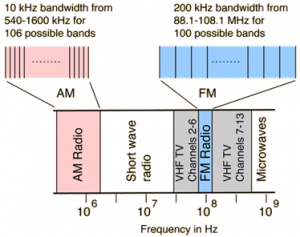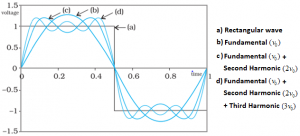Bandwidth of a Signal
What is Bandwidth of a Signal?
Bandwidth is a range of frequencies within a continuous set of frequencies. It is measured in Hertz. The purpose of a communication system is to transfer information from the transmitter which is located at one place to a receiver which is usually far away from the transmitter. When we send an email, we are sending it as bits of information to the receiver. This information is transported over the air or wire at a certain frequency depending on the mode chosen. Another factor at play is that the information can be in many forms: voice, video, photo, word document, etc. Luckily there is a very large spectrum of frequencies waiting for our bidding.

The smaller frequencies are used for long distance communication and can travel unaffected over large distances, i.e., less attenuation. Larger frequencies have greater energy and can carry more information but they are very inefficient and cannot be transmitted over long distances. One such set of frequencies are used for a very different purpose than others, i.e. the microwaves. For transmitting sounds or speech, frequency range of 300 Hz to 3100 Hz is sufficient and hence the current telephones operate at a bandwidth of 2800 Hz. Transmission of music requires a bandwidth of signal of 20 kHz because of the various instruments with a variety of pitches. The audible range of a human is from 20 Hz to 20 kHz where as a dog can hear from 50 Hz to 46 kHz. The key characteristic of bandwidth is that any band of a given width can carry the same amount of information, regardless of where the band is located in the frequency spectrum. For example, a 4 kHz signal bandwidth can transmit a telephone conversation whether it is through lower frequency, like a wired telephone or modulated to a higher frequency, i.e. cell phone.
Digital signals are in rectangular form, either on or off, i.e. 1 or 0. The sine wave is the fundamental waveform and every other kind of waveform (triangular, rectangular as in digital) can be written as a combination of the fundamental sine wave. We get digital pulses when we superimpose sine waves of different harmonics.

Bandwidth of Transmission Medium: There are various methods of transmission, yes lots of them. From smoke signals and beating drums to the current fiber optics. The amount of data these various methods can transfer differ hugely. During the 1990’s and the early 2000’s India had dial up internet which was really slow but now with infrastructure changes we have faster internet. Wires are the most commonly used transmission media. A wire offers a bandwidth of approximately 750 MHz the transmission over air and free space range from a few hundred kHz to a few GHz. An optical fiber can offer a signal bandwidth of over 100 GHz.
